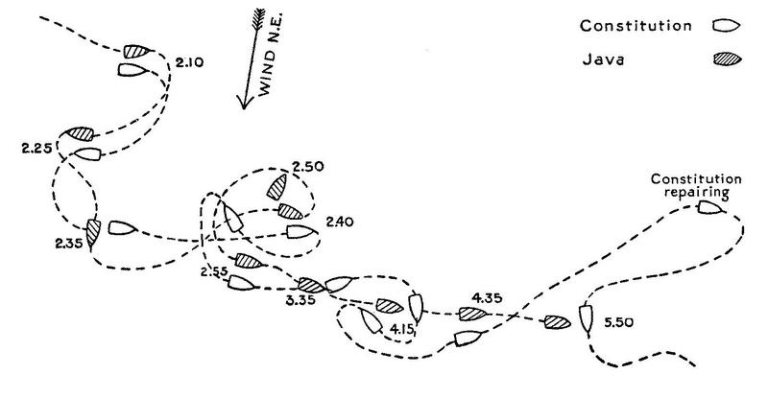Prelude
On December 13, 1812, sailing from Boston by way of Cape Verde, USS Constitution, under the command of Captain William Bainbridge, accompanied by USS Hornet, commanded by James Lawrence, arrived off the coast of Brazil at St. Salvador.
On December 26, The Hornet was sent into port to communicate with the American consul. Three days later, at 9:00 AM, the Constitution spotted British sails. The two ships exchanged signals and prepared for battle.
Jump to:
The Battle
The fighting began shortly after 2:00 PM with a long-range artillery barrage. The Constitution took some damage when the wheel was shot away, but overall, the ship absorbed the rounds. The crew got the Constitution under control, despite the wheel being lost, and then began to close in on the British.
The two ships began to fire at close quarters, but the Java was overmatched.
The Java's captain, Henry Lambert, took a mortal wound from a rifle, and its crew took 100 casualties. The Java quickly struck her colors and surrendered.
Unfortunately, the Java had taken so much damage that she could not be taken as a prize. The Constitution had overwhelmed Java despite having a smaller crew. The victory proved to help continue the rise of the American Navy.

This excerpt comes from the Department of the Navy's Website:
The following Minutes Were Taken during the Action
| At 2.10. P.M, | Shot away The enemies Main Topmast just above the Cap |
| At 2,30. P.M, | our wheel was shot entirely away |
| At 2.40. | determined to close with the Enemy, notwithstanding her rakeing, set the Fore sail & Luff'd up close to him. |
| At 2,50, | The Enemies Jib boom got foul of our Mizen Rigging |
| At 3 | The Head of the enemies Bowsprit & Jib boom shot away by us |
| At 3.5 | Shot away the enemies foremast by the board |
| At 3.15 | Having silenced the fire of the enemy completely and his colours in main Rigging being [down], Supposed he had Struck, Then hawl'd about the Courses to shoot ahead to repair our rigging, which was extremely cut, leaving the enemy a complete wreck, soon after discovered that The enemies flag was still flying hove too to repair Some of our damages. |
| At 3.40 | Shot away Gafft and Spunker boom |
| At 3.55 | Shot his mizen mast nearly by the board |
| At 4.5 | Having silenced the fire of the enemy completely and his colours in main Rigging being [down] Supposed he had Struck, Then hawl'd about the Courses to shoot ahead to repair our rigging, which was extremely cut, leaving the enemy a complete wreck, soon after discovered that The enemies flag was still flying hove too to repair Some of our damages. |
| At 4.20. | The Enemies Main Mast went by the board. |
| At 4.50 | [Wore] ship and stood for the Enemy |
| At 5.25 | Got very close to the enemy in a very [effective] rakeing position, athwart his bows & was at the very instance of rakeing him, when he most prudently Struck his Flag. |
Aftermath
Upon learning of the death of Captain Lambert, Commodore Bainbridge expressed deep sorrow for a commander he credited to be brave and noble.
On April 23, 1813, Lieutenant Chads and the other surviving officers and men of Java faced the customary court-martial aboard HMS Gladiator for the loss of their ship. They were honorably acquitted.
When the British Admiralty learned of the defeat, it ordered that from that point forward, American frigates should be fought only by two or more British ships of similar force.
Captain William Bainbridge earned himself a Congressional gold medal and became another U.S. naval hero.
